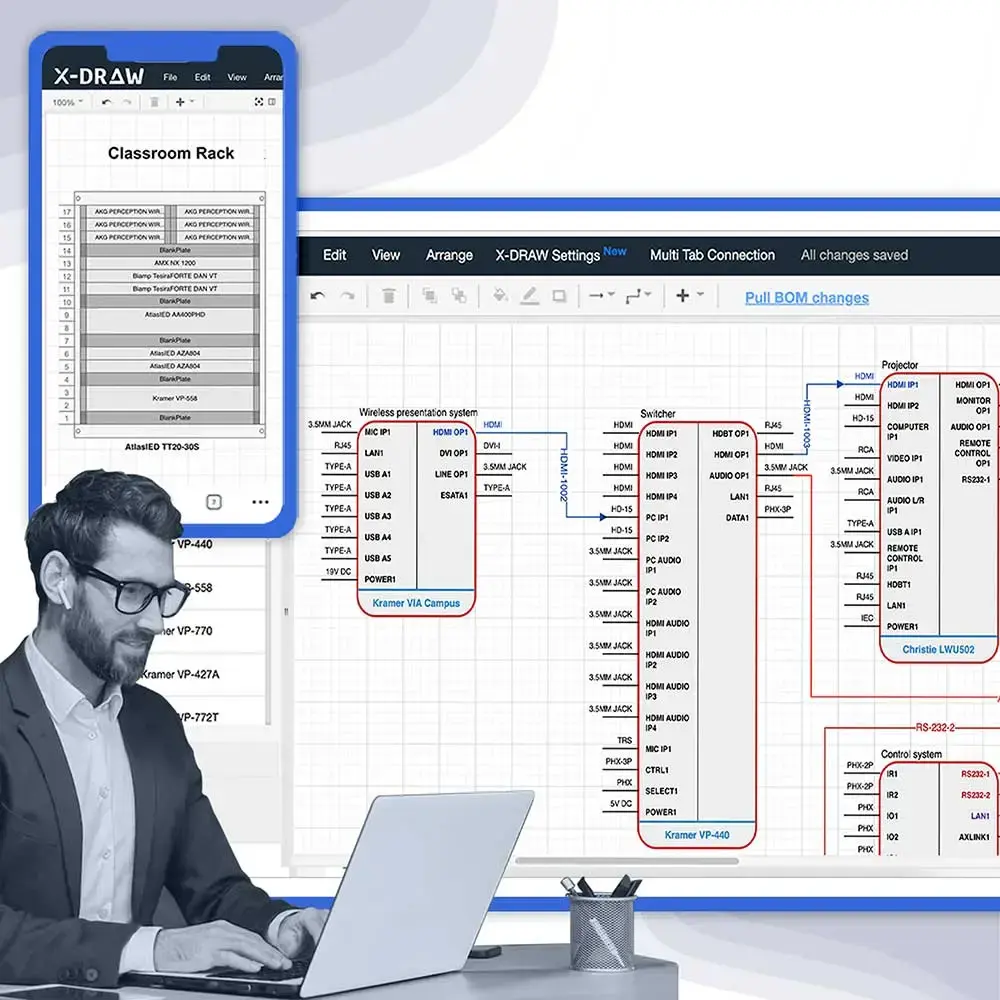Checkout This Quick Guide to Master Audio Systems and Design

Understanding the principles of designing audio systems is vital when aiming to create the audio experience. In both residential settings, there are four components that form the foundation of every high-quality system. It’s interesting to note that by 2021 the global audio equipment industry is projected to reach a value of $17.52 billion.
This demonstrates the increasing demand for notch solutions. Whether it’s the source or a powerful amplifier each component plays a crucial role in ensuring that every note rhythm and word is conveyed accurately and clearly. So whether you’re assembling a home theater system design or outfitting a large event venue join us as we delve into the essentials; source, amplifier, volume control, and speakers.
What Types of Installed Audio Systems Are There?
When you delve into the world of audio system installation, you’ll come across an array of choices that cater to needs and settings. So, let’s embark on this journey together and explore the types of installed audio-video systems that could be a perfect match for you!
In-Ceiling Speakers
There are types of audio systems, for installation each designed to cater to specific requirements and environments. One popular choice is In Ceiling Speakers, which seamlessly blend into the ceiling saving floor space. They are versatile. Can create an audio experience in both homes and businesses. If you desire a sound system setup without equipment in ceiling speakers may be the perfect fit for you.
Wall-Mounted Speakers
Another option worth considering is Wall Mounted Speakers. These speakers elegantly adorn your walls while delivering audio without the need for equipment. They are a choice when ceiling installation is not possible. If you appreciate the idea of integrating speakers into your decor while enjoying sound quality, wall-mounted speakers might be the solution you’ve been searching for.
Wireless Audio Systems
For those seeking convenience and freedom from wiring Wireless Audio Systems provide a solution. These systems eliminate the need for connections offering flexibility in speaker placement. They are particularly suitable for homes and businesses looking to streamline their setup. If you’re ready to embrace a wire audio experience wireless systems are definitely worth exploring.
Outdoor Audio Systems
You can also transform your space into an entertainment hub, with Outdoor Audio Systems. These speakers are built to endure weather conditions guaranteeing sound performance, in outdoor settings. Whether you’re organizing a get-together in your backyard or simply unwinding by the poolside, outdoor audio systems elevate your experience by providing music. If you imagine yourself enjoying music while surrounded by the sky, investing in speakers could be a worthwhile enhancement for your outdoor area.
Multi-Zone Audio Systems
For homes or commercial establishments Multi Zone Audio Systems offer an audio experience in different zones. These systems allow for sources in various areas giving you the freedom to have individualized audio settings. Whether you’re hosting events in spaces or simply desire audio options throughout your property, multi-zone audio systems provide the flexibility and versatility you require. If you’re seeking to customize your experiences, in parts of your space incorporating a multi-zone system could be an excellent choice.
4 Essential Elements for Commercial & Residential Audio Systems Design
There are four elements that are crucial, in designing audio systems for both commercial and residential purposes. Let’s take a look at each of these elements as balancing them properly is key to creating a system that functions well and provides an enjoyable experience.
It’s also important to take into account factors such as room acoustics, wiring, and how the system integrates with components. By selecting and configuring these elements both commercial and residential audio systems can deliver exceptional sound experiences.
Audio Source
In the realm of both commercial audio system and residential sound system design four fundamental elements play a role. The first element is the Audio Source, which serves as the origin of the sound. This can include devices like music players, microphones, televisions, or computers— any device that generates a signal. In settings everyday devices like smartphones, laptops, turntables, or streaming platforms can serve as sources of sound. On the hand in setups sources may involve microphones, mixers or background music systems.
Amplifier
Next on the list is the Amplifier—a component for boosting the low-level audio signal from the source to a level capable of effectively driving speakers. Amplifiers come in forms such as integrated amplifiers, power amplifiers, or AV receivers—depending on factors like the power requirements of the system and optimal performance needs, in terms of channels.
Volume Control
Volume Control is a function that allows users to modify the output volume. This is necessary to guarantee a good listening experience. Controlling the volume in the house may be as simple as turning a knob or using a remote control. However, in certain systems, complex configurations, such as zone-specific volume controls or digital signal processing (DSP) units, may be required.
Speakers
Lastly we reach the Speakers, who play a role in the audio chain. They transform the amplified audio signal into waves that we can hear. Choosing the speakers is crucial for achieving the desired quality and coverage. Factors like speaker type (bookshelf floor standing, in the ceiling) and proper placement have an influence in this context.
Designing Principles For Audio Systems
When it comes to designing audio systems it is crucial to follow principles in order to achieve performance and satisfy users. Here are some key principles to consider when designing audio systems;
Determine The Purpose of The Sound System
Begin by defining the objectives of the sound system. This could include providing speech reinforcement delivering high-quality music playback or accommodating multimedia presentations. Understanding the intended use will help tailor the system to meet requirements.
Consider The Acoustics Of The Venue
Conduct an assessment of the venue’s properties taking into account factors such, as room size, shape, and materials used. Analyzing the acoustics will inform decisions about speaker placement, dispersion, and how to address any acoustic challenges.
Choose The Right Audio Equipment
Select audio equipment based on both the purpose of the system and the specific acoustics of the venue. This includes choosing speakers, amplifiers, microphones, signal processors and other necessary components. The compatibility and quality of these chosen components are crucial for achieving the desired performance.
Plan For Future Expansion
Anticipate future needs when designing the system and ensure that it allows for scalability and flexibility. Consider incorporating features like input/output channels or expansion slots that can accommodate evolving requirements or future technologies.
Test And Fine-Tune The Audio Video Systems
Rigorous testing and calibration are steps in ensuring the performance of the audio system in its designated environment. Make sure to test the sound, make any adjustments, to the settings, and fine-tune the parameters in order to achieve a well-balanced distribution of sound, proper coverage, and the best possible quality.
Best Audio Systems Design Software
Are you tired of doing everything manually, especially the designing part? So, here’s what we propose: check out the best sound system design software X-DRAW to ease your work and stand out from the crowd. Here’s what you can explore with our 15-day free trial.
- Comprehensive Database: whenever we talk about AV designs all one thinks is if they could get a wide library. So here we are with an extensive database of over 1.5 million products from over 5200 brands. But we won’t stop here our system is updated on a regular basis, so AV designers are able to benefit from all the latest equipment.
- Intelligent Product Matching: Our experts have trained the algorithm to suggest the best products that are suitable for the current project you’re working on. It also shows the “most preferred” products, so you don’t have to keep searching for them repeatedly. This feature helps designers make informed decisions and optimize system performance.
- Acoustic Modeling and Simulation: We provide tools that simulate the performance of a space. Designers can analyze factors, like reverberation, sound distribution, and speech clarity to ensure audio quality in the final setup.
- Cost Estimation and Budgeting: Our audio system design software also offers features to estimate project costs based on selected equipment and design parameters. This helps designers stay within budget constraints and provides pricing information to clients.
- Collaboration and Documentation Tools: We promote collaboration among team members by offering tools for documentation, annotations, and project sharing. This ensures that all stakeholders have access to up-to-date project information.
- Vendor and Project Management: Designers can conveniently track vendor details, project timelines, and deliverables within the software. This centralizes project management processes. Helps maintain a workflow.
- Ease of Learning and Support: You get user-friendly interfaces and comprehensive documentation making it accessible for both experienced designers and those new, to AV system design. Additionally, our dedicated customer support is available to assist with any inquiries or assistance needed.
Audio Design Mastery + Winning Proposals = 10x Productivity!
- Automatic Cable Labeling & Styling
- 100+ Free Proposal Templates
- Upload & Create Floor Plans
- 1.5M Products from 5200 Brands
- AI-powered ‘Search Sense'
- Legally Binding Digital Signatures
Conclusion
We break down the elements of designing a system. By understanding these components you can create environments that resonate with power and clarity in today’s paced world, where exceptional audio experiences are no longer a luxury but a necessity.
The global market for equipment is expected to grow at a compound annual growth rate (CAGR) of 4.6%, by 2020 indicating a thriving industry committed to producing top-notch sound quality. Hope this was a helpful guide and you were able to better understand audio systems.
Frequently Asked Questions (FAQ's)
When experts plan and design the major focus is the sound emitted and absorbed in the specific environment they are working for. This makes it important for them to consider the acoustics of the environment for giving out the best results through their unique designs.
A sound system usually includes a lot of different equipment for smooth functioning but here are the 4 main elements that a sound system must have:
- Audio Source
- Amplifier
- Volume Control
- Speakers
The audio video system should provide clear, balanced audio across all frequencies, with sufficient power, quality components, proper calibration, and compatibility with various audio sources for optimal performance, ensuring accurate reproduction of low bass tones to high-frequency details.
Equipment malfunction, power difficulties, overloading, faulty wiring, environmental conditions, software issues, wrong settings, physical damage, aging components, interference, and human mistakes can all cause sound system failures. Maintenance and competent installation are essential.
